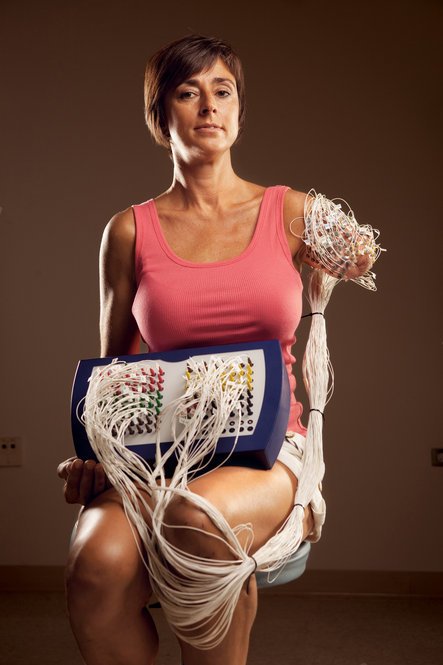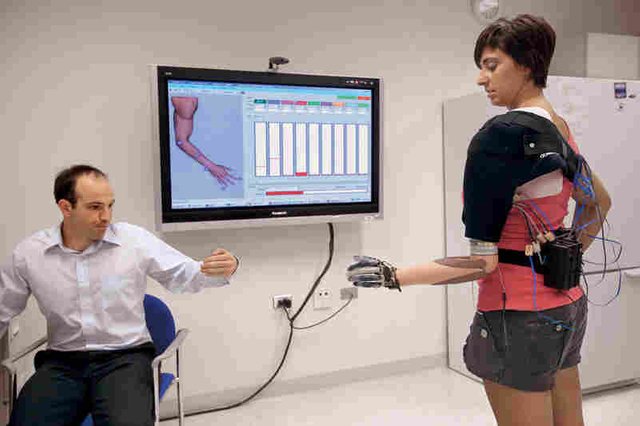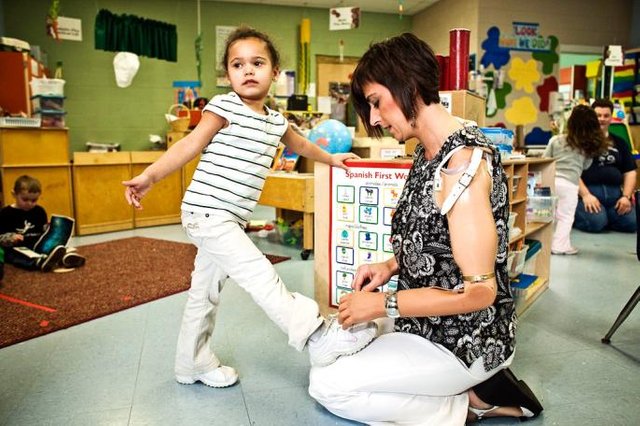Scientists more and more successfully replace damaged organs and amputated limbs of people with complex mechanisms. As a result, the blind acquire vision, the deaf - the ability to hear, and the disabled can control prosthetic hands with the help of the power of thought alone. What new opportunities will give people a union of reason and technology?

Forty-four-year-old Amanda Kitts cheerfully enters the class. Your favorite teacher is immediately surrounded by a crowd of kids four or five years old. "How's my crumbs doing today?" Amanda asks, ruffling the children's hair with her hand-her unusual, experimental, artificial hand.
"Make it something funny," one girl asks. "Funny? Remember how I can shake hands? "- Amanda straightens her elbow and turns her wrist. One of the boys hesitantly touches the slightly bent plastic fingers. He does not even suspect how many scientists had to work so that Amanda, who lost her hand in a car accident, could manage her artificial limb with just one thought.
Ordinary hand prostheses are hooks and hinges, cables or motors controlled by levers. To stretch such a hand forward, you have to turn your head and press your chin on the lever. It is awfully uncomfortable-it is not surprising that many people with disabilities eventually refuse such prostheses.
It's quite another thing - Amanda's hand. Under the plastic flesh color hidden metal frame, three motors and a complex electro-system. The whole design is completed in the biceps area, where the white plastic cover covers the stump that is left of the real arm. And to commit an action, Amanda just needs to just want it.
The fact is that even if the flesh and bones are damaged or destroyed, the nerves and parts of the brain that they controlled continue to live. The brain is still ready to command an amputated part of the body, nerves - to pass his orders, but only there is nobody to execute them. So, to help people with disabilities, you need to create new "subordinates" and teach them to understand and execute the commands of the brain. Fantastic? But as a result of such operations, the blind are now seeing, the deaf are able to hear, and Amanda Kitts folds her clothes on her own. The mechanisms that serve them are called neuroprosthetics, or bionics: scientists have already reconciled themselves to the term invented by science fiction writers.
The "Bionic Hand" came about thanks to Todd Kuiken, a physician and biomedical engineer from the Chicago Institute of Rehabilitation (CHIR). The main question that Todd had to solve was: how to connect the brain signals and the computer that controls the electric motors in the prosthesis? The nerves also conduct electricity, but they can not be joined to a computer wire: the nervous tissue and metal wires do not fit well together; besides, an open wound in the place where the wire enters the body is dangerous, because an infection can penetrate through it.

Kuiken needed a natural amplifier for the signals coming from the nerves. He found that with this role ... the muscles cope. Cutting, they produce an electrical splash, strong enough to be caught by the electrode placed on the skin. Todd developed a technology that allows you to redirect the nerves from the damaged places, where they led before, to other muscles that can properly amplify the signals.
In 2002, the operation was carried out for the first time. Four years later Tommy Kitts read about this on the Internet. His wife Amanda was at that time in the hospital - after a car accident she was amputated to her arm just above the elbow.
"I was tormented by anger, anguish and depression. I could not accept what happened, and did not understand how God allowed it to happen to me, "Amanda recalls. But Tommy's story aroused her hope, and soon the couple was already flying on an airplane to Illinois.
Quicken started work with Amanda Kitts. The first thing was to release the nerves that used to go to the very end of her hand. "A healthy hand and a brush are controlled by the same nerves, but we had to create four different muscle regions and send them there," Quicken explains. Nerves began in the motor cortex of Amanda's brain, where the "map" of the human body is located, but ended in the cult. During a complex operation, the surgeon redirected these nerves to different areas of the muscles of the upper arm. After that, nerves grew for several months, slowly coming to the places of their new habitat.
"Three months later, I began to feel a slight tingling and twitching," recalls Amanda. - Four months later, when I touched the upper part of my hand, how I began to feel the brush! Touching different areas, I felt different fingers. " These were the fingers of that phantom arm, the image of which was stored in her brain and now was again connected to the flesh. When Amanda thought about how she moved the phantom fingers, the real muscles contracted at the top of her arm.
A month later, she was fitted with a bionic arm, equipped with electrodes that caught the signals of the muscles. From the site in the cult, violent streams of electrical noise broke out, and among them were the signals: "straighten the elbow" or "turn the wrist." Now it was necessary to program the microprocessor in the prosthesis so that the electrodes would recognize the necessary signals and send them to the correct motor.
This was made possible by Amanda's phantom arm. Blair Locke, a research engineer, is debugging a program in one of the ChIR laboratories. He asks Amanda to remove an artificial hand and attach electrodes to the cult. A woman stands in front of a large flat screen, on which appears a hand separated from the body, floating in the blue space - a visual image of the same phantom. Electrodes catch the commands sent by Amanda's brain, and the virtual arm moves.
Quietly, as if afraid of disturbing Amanda's concentration, Lok asks him to bend the palm to himself - and the brush on the screen bends as it should. "Now straighten your wrist with your palm upward." The hand on the screen makes the required movement. "Better than last time?" - with a hope the patient asks. "Oh yeah! Very strong signals, "- says Blair. Amanda laughs. Then Lock asks her to draw a thumb parallel to the rest. The hand on the screen obeys.

Amanda opens her eyes wide with surprise. "I did not know that I could do all this!" Once you can identify the next signal associated with a particular movement, the program of a computer hidden in your hand makes the task to track it and, catching, activate the necessary motor.
I watch as Amanda in the kitchen makes a peanut butter sandwich. A striking sight! A healthy hand holds a piece of bread, in the artificial fingers a knife is clamped, the elbow bends, Amanda smoothly spreads peanut butter: back and forth. Before, it was not easy, but the more Amanda trains, the more natural her movements become. Now the woman most would like to restore the ability to touch. This would make her life much easier - for example, it would be easier to drink coffee.
According to Quicken, the likelihood that Amanda will regain touch is great - the PIR is already developing a new model for Amanda and other patients. The new arm is equipped not only with additional motors and joints, but also pressure sensitive pads at the fingertips. These pads are connected to small, piston-like stems, which rest against the muscles. The muscles further transmit the signal to the brain through the nerves that "respond" to the fingers - and, accordingly, the stronger the pressure, the clearer the sensation in the fingers of the existing phantom in Amanda's head.
Testing the model, the patient can understand the strength with which she squeezes her fingers. And according to the vibration frequency of the rods, it is able to distinguish surfaces - rough (sandpaper) or smooth (glass). Amanda dreams of the day when the new model is fully debugged and given to her in undivided use.
Neuroprosthetics is rapidly developing. Participants in the BrainGate project are already directly trying to connect the cerebral cortex of paralyzed people to the computer so that they can move objects at a distance with a thought effort. While it was possible to achieve that patients get to move the cursor on the monitor. Scientists even plan to create an artificial hippocampus - a part of the brain that stores memories - to help people suffering from memory loss.
Of course, not everything works perfectly. One of the first patients BrainGate asked to detach himself from the computer, because the wire interfered with the work of other devices that helped him. And Jo Anne Lewis says she does not see well enough to dare to cross the street. "We give people tools," Todd Quicken explains. "But these tools are still gross enough compared to the complex device of the human body - it's like a candle compared to the sun."
Let it be so. However, people who already use these tools can at least keep a candle in their hand. Or to distinguish its flicker in the impenetrable darkness.
fascinating read and revelation that despite the technology angst of robots replacing mankind, technology and science is build on empathy
Downvoting a post can decrease pending rewards and make it less visible. Common reasons:
Submit
I admire more people who can survive these difficulties, who do not lose hope, who do not give up as bad as they were not.
Downvoting a post can decrease pending rewards and make it less visible. Common reasons:
Submit
Welcome to steemit @floxxy!
This was an interesting post. Since you put so much effort in writing it, would you consider adding some references, because it's always advisable to acknowledge the work of those we turn to for information?
That way, your post will gain in credibility as well.
Thank you! :)
Downvoting a post can decrease pending rewards and make it less visible. Common reasons:
Submit
Thank you for reading) Well I will take note, but the information had to be collected through facebook for a long time. You have a very interesting blog, you made me smile and remember how we conducted experiments at school)
Downvoting a post can decrease pending rewards and make it less visible. Common reasons:
Submit
Just keep it in mind for future posts ;)
You can also use the #steemstem tag for your science related topics.
And thank you for going through my blog! I'm happy that you liked it! :D
Downvoting a post can decrease pending rewards and make it less visible. Common reasons:
Submit
I'm afraid to climb into other people's tags) If I can write something worthwhile then I'll definitely use it. Thanks for the advice)
Downvoting a post can decrease pending rewards and make it less visible. Common reasons:
Submit
Sure, I only made a suggestion. You can try it whenever you feel like it! :)
Downvoting a post can decrease pending rewards and make it less visible. Common reasons:
Submit
@originalworks
Downvoting a post can decrease pending rewards and make it less visible. Common reasons:
Submit
The @OriginalWorks bot has determined this post by @floxxy to be original material and upvoted it!
To call @OriginalWorks, simply reply to any post with @originalworks or !originalworks in your message!
To enter this post into the daily RESTEEM contest, upvote this comment! The user with the most upvotes on their @OriginalWorks comment will win!
For more information, Click Here! || Click here to participate in the @OriginalWorks sponsored writing contest(125 SBD in prizes)!
Special thanks to @reggaemuffin for being a supporter! Vote him as a witness to help make Steemit a better place!
Downvoting a post can decrease pending rewards and make it less visible. Common reasons:
Submit